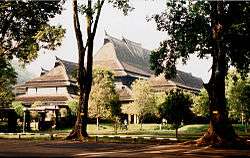Bandung
Bandung (/ˈbɑːndʊŋ/) is the capital of West Java province in Indonesia. Based on the official mid-2020 estimate, it is Indonesia's fourth most populous city after Jakarta, Surabaya, and Bekasi with 2,510,103 inhabitants.[4] Greater Bandung is the country's third-largest metropolitan area with over 8.5 million inhabitants.[5] Located 768 metres (2,520 feet) above sea level, approximately 140 kilometres (87 miles) southeast of Jakarta, Bandung has cooler year-round temperatures than most other Indonesian cities. The city lies on a river basin surrounded by volcanic mountains that provides a natural defence system, which was the primary reason for the Dutch East Indies government's plan to move the capital from Batavia (modern-day Jakarta) to Bandung.
Bandung | |
|---|---|
| City of Bandung Kota Bandung | |
| Other transcription(s) | |
| • Sundanese | ᮊᮧᮒ ᮘᮔ᮪ᮓᮥᮀ |
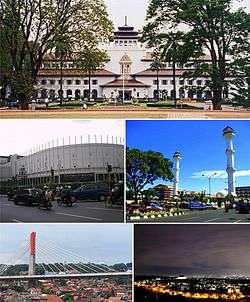 Clockwise, from top: Gedung Sate, Grand Mosque of Bandung, Bandung at night, Pasupati Bridge, Merdeka Building | |
 Flag  Coat of arms | |
| Nicknames: Kota Kembang (City of Flowers) Parijs van Java (Dutch) (Paris of Java) | |
| Motto(s): Clean, Prosperous, Devout, Friendly | |
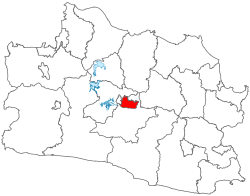 Location within West Java | |
| Coordinates: 6°54′43″S 107°36′35″E | |
| Country | |
| Province | |
| Founded | 25 September 1810[1] |
| Incorporated (as gemeente) | 1 April 1906[1] |
| Administrative division | 30 districts 153 urban villages |
| Government | |
| • Body | Bandung City Government |
| • Mayor | Oded Muhammad Danial (PKS) |
| • Vice Mayor | Yana Mulyana |
| Area | |
| • Total | 167.67 km2 (64.74 sq mi) |
| • Metro | 1,876.8 km2 (724.6 sq mi) |
| Elevation | 768 m (2,520 ft) |
| Population (2015) | |
| • Rank | 3rd |
| • Urban | 2,575,478 |
| • Metro | 8,201,928 (3rd) |
| Demonyms | Bandungite Warga Bandung (id) Urang Bandung (su) |
| Demographics | |
| • Ethnic groups | Sundanese Javanese Chinese Arab Korean Indian |
| • Religion[2] | Islam 91.70% Protestantism 5.36% Catholicism 1.95% Buddhism 0.49% Hinduism 0.09% Confucianism 0.03% Others 0.02% |
| • HDI | |
| Time zone | UTC+7 (Indonesia Western Time) |
| Postcodes | 401xx, 402xx, 406xx |
| Area code | (+62) 22 |
| 2,510,103Registration plate | D |
| GRP | 2019 estimate |
| GDP Nominal | |
| GDP PPP | |
| Percapita Nominal | |
| Percapita PPP | |
| Largest district by area | Gedebage – 9.58 square kilometres (3.70 sq mi) |
| Largest district by population | Babakan Ciparay (147,388 – 2015 est) |
| Website | bandung.go.id |
The Dutch first established tea plantations around the mountains in the 18th century, and a road was constructed to connect the plantation area to the colonial capital Batavia (180 kilometres (112 miles) to the northwest). In the early 20th century the Dutch inhabitants of Bandung demanded the establishment of a municipality (gemeente), which was granted in 1906, and Bandung gradually developed into a resort city for plantation owners. Luxurious hotels, restaurants, cafés, and European boutiques were opened, leading the city to be nicknamed Parijs van Java (Dutch: "The Paris of Java").
After Indonesia declared independence in 1945, the city has experienced ongoing development and urbanisation, transforming from an idyllic town into a dense 16,500 people/km2 (per square kilometre) metropolitan area with living space for over 8 million people. New skyscrapers, high-rise buildings, bridges, and gardens have been constructed. Natural resources have been heavily exploited, particularly by conversion of the protected upland area into highland villas and real estate. Although the city has encountered many problems (ranging from waste disposal and floods, to a complicated traffic system resulting from a lack of road infrastructure), it still attracts large numbers of tourists, weekend sightseers, and migrants from other parts of Indonesia. In 2017 the city won a regional environmental sustainability award for having the cleanest air among major cities in ASEAN.[6] The city is also known as a Smart City, leveraging technology to improve government services and social media, that alert residents to issues such as floods or traffic jams. Bandung is Indonesia's major technology center.[7][8]
The first Asian-African Conference, the Bandung Conference, was hosted in Bandung by President Sukarno in 1955. Redevelopment of the existing Bandung international airport (BDO) was completed in 2016. To improve infrastructure, the construction of a Jakarta-Bandung High-speed rail was started in 2016, with projected completion in 2021. This is to be complemented by an indigenous type of Automated People Mover (APM) and Light Rail Transit (LRT).[9][10] The new larger second airport, Bandung Kertajati International Airport opened in June 2018, just in time for the Asian Games 2018.
History
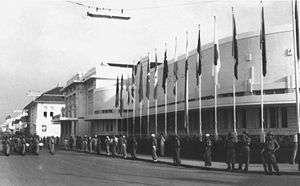
The official name of the city during the colonial Dutch East Indies period was Bandoeng. The earliest reference to the area dates back to 1488, although archaeological findings suggest a type of Homo erectus species had long previously lived on the banks of the Cikapundung River and around the old lake of Bandung.[11] During the 17th and 18th centuries, the Dutch East Indies Company (VOC) established plantations in the Bandung area. In 1786, a supply road connecting Batavia (now Jakarta), Bogor, Cianjur, Bandung, Sumedang and Cirebon was constructed. In 1809, Napoleon Bonaparte, French Emperor and conqueror of much of Europe including the Netherlands and its colonies, ordered the Dutch Indies Governor H.W. Daendels to improve the defensive systems of Java to protect against the British in India. Daendels built a road, stretching approximately 1,000 km (620 mi) from the west to the east coast of Java, passing through Bandung.[12][13] In 1810, the road was laid down in Bandung and was named De Groote Postweg (or the 'Great Post Road'), the present-day location of Jalan Asia-Afrika. Under Daendels' orders, R. A. Wiranatakusumah II, the Chief Administrator of the Bandung regency at that time, moved the office from Krapyak, in the south, to a place near a pair of holy city wells (sumur Bandung), the present-day site of the city square (alun-alun). He built his dalem (palace), masjid agung (the grand mosque) and pendopo (public-official meeting place) in the classical Sundanese orientation,[14] with the pendopo facing Tangkuban Perahu mountain, which was believed to have a mystical ambience.
.svg.png)
In 1880, the first major railroad between Batavia and Bandung was completed,[15] boosting light industry in Bandung. Chinese flocked into the city to help run facilities, services and as vendors. The area adjacent to the train station is still recognisable as the old Chinatown district. In 1906, Bandung was given the status of gemeente (municipality), and then twenty years later, stadsgemeente (city municipality).
Beginning of time the early 1920s, the Dutch East Indies government made plans to move their capital from Batavia to Bandung. Accordingly, during this decade, the Dutch colonial government commenced construction of military barracks, the central government building (Gouvernments Bedrijven, the present-day Gedung Sate) and other government buildings. However, this plan was cut short by World War II, after which the Dutch were not able to re-establish their colony due to the Indonesian Declaration of Independence.
The fertile area of the Parahyangan Mountains surrounding Bandung supports productive tea plantations. In the nineteenth century, Franz Junghuhn introduced the cinchona (kina) plant.[16] With its cooler elevated landscape, surrounded by major plantations, Bandung became an exclusive European resort area.[17] Wealthy plantation owners visited the city on weekends, attracting ladies and business people from the capital, Batavia. Jalan Braga grew into a promenade street with cafés, restaurants and boutique shops. Two art-deco style hotels, Savoy Homann and Preanger, were built in the vicinity of the Concordia Society, a clubhouse for the wealthy with a large ballroom and a theatre.[15]
After Indonesian independence in 1945, Bandung was designated as the capital of West Java province. During the Indonesian National Revolution, some of the most massive battles occurred in and around Bandung. Dutch troops were virtually absent in Java at the end of World War II. To assist the restoration of Dutch sovereignty, the British took a military hold on Java's major cities, and the British military commander set an ultimatum for the Indonesian combatants in Bandung to leave the city. In response, on 24 March 1946, much of the southern part of Bandung was deliberately set alight as the combatants left; an event known as Bandung Lautan Api or the 'Bandung Sea of Fire'.[18]
In 1955, the first Asian-African Conference, also known as the Bandung Conference, was hosted in Bandung by President Sukarno, and attended by the heads of states representing twenty-nine independent countries from Asia and Africa.[19] The conference venue was at the Gedung Merdeka, the former Concordia Society building. The conference announced ten points of declaration for the promotion of world peace and opposition against colonialism and is known as the Declaration of Bandung. This was followed by a wave of nationalism and decolonisation movements around the globe which remapped world politics.[20] The conference was also the first international conference of people of colour in history.[21] In his book The Color Curtain, Richard Wright claims that there was an epic meaning of the conference for people of colour around the world.[21]
In 1987, the city boundary was expanded by the 'Greater Bandung' (Bandung Raya) plan; with the relocation of higher concentration development zones outside the city in an attempt to dilute population density in the old city. During this development, the city core was often uprooted, with old buildings torn down, lot sizes regrouped and rezoned, changing idyllic residential areas to commercial zones with bustling chain supermarkets, malls, banks and upscale developments.[17]
In 2005, an Asian-African Conference was partly held in Bandung, attended by world leaders such as Indonesian President Susilo B. Yudhoyono, President of China Hu Jintao, Prime Minister of India Manmohan Singh, President of South Africa Thabo Mbeki, President of Nigeria Obasanjo, and other luminaries.[22]
Geography
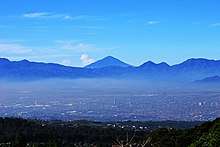
Bandung, the capital of West Java province, located about 180 kilometres (110 mi) southeast of Jakarta, is the third-largest city in Indonesia. Its elevation is 768 metres (2,520 ft) above sea level and is surrounded by up to 2,400 metres (7,900 feet) high Late Tertiary and Quaternary volcanic terrain.[23] The 400 km2 flat of central Bandung plain is situated in the middle of 2,340.88 square kilometres (903.82 sq mi) wide of the Bandung Basin; the basin comprises Bandung, the Cimahi city, part of Bandung Regency, part of West Bandung Regency, and part of Sumedang Regency.[24] The basin's main river is the Citarum; one of its branches, the Cikapundung, divides Bandung from north to south before it merges with Citarum again in Dayeuhkolot. The Bandung Basin is an essential source of water for potable water, irrigation, and fisheries, with its 6,147 million m3 (217.1 billion cu ft) of groundwater being a significant reservoir for the city.[24] The northern section of Bandung is hillier than other parts of the city, and the unique truncated flat-peak shape of the Tangkuban Perahu volcano (Tangkuban Perahu literally means 'upside-down boat') can be seen from the city to the north. Long-term volcanic activity has created fertile andisol soil in the north, suitable for intensive rice, fruit, tea, tobacco, and coffee plantations. In the south and east, alluvial soils deposited by the Cikapundung river predominate.

Geological data shows that the Bandung Basin is located on an ancient volcano, known as Mount Sunda, erected up to 3,000–4,000 metres (9,800–13,100 feet) during the Pleistocene age.[25] Two large-scale eruptions took place; the first formed the basin and the second (est. 55,000 BCE) blocked the Citarum river, turning the basin into a lake known as "the Great Prehistoric Lake of Bandung".[26] The lake drained away; for reasons which are the subject of ongoing debate among geologists.[27][28]
Climate
Bandung experiences tropical monsoon climate (Am) according to Köppen climate classification as the driest month precipitation total is below 60 millimetres (2.4 in), bordering with subtropical highland climate (Cfb). The wettest month is February with precipitation total 255.0 millimetres (10.04 in), while the driest month is September with precipitation total 50.0 millimetres (1.97 in). The average temperature throughout the year tends to be cooler than most cities in Indonesia due to the altitude influence. The average temperature throughout the year only has little variation due to its location near the equator.
| Climate data for Husein Sastranegara International Airport, Bandung, West Java, Indonesia (temperature: 1972-1994, precipitation: 1957-1994) | |||||||||||||
|---|---|---|---|---|---|---|---|---|---|---|---|---|---|
| Month | Jan | Feb | Mar | Apr | May | Jun | Jul | Aug | Sep | Oct | Nov | Dec | Year |
| Record high °C (°F) | 32.2 (90.0) |
31.1 (88.0) |
32.2 (90.0) |
30.6 (87.1) |
31.1 (88.0) |
30.6 (87.1) |
30.6 (87.1) |
31.1 (88.0) |
32.8 (91.0) |
34.4 (93.9) |
33.9 (93.0) |
31.1 (88.0) |
34.4 (93.9) |
| Average high °C (°F) | 27.2 (81.0) |
26.7 (80.1) |
27.2 (81.0) |
27.8 (82.0) |
27.8 (82.0) |
27.8 (82.0) |
27.8 (82.0) |
28.3 (82.9) |
28.9 (84.0) |
28.9 (84.0) |
27.8 (82.0) |
27.2 (81.0) |
27.8 (82.0) |
| Daily mean °C (°F) | 23.3 (73.9) |
23.1 (73.6) |
23.3 (73.9) |
23.6 (74.5) |
23.3 (73.9) |
22.8 (73.0) |
22.5 (72.5) |
22.8 (73.0) |
23.3 (73.9) |
23.6 (74.5) |
23.3 (73.9) |
23.3 (73.9) |
23.2 (73.8) |
| Average low °C (°F) | 19.4 (66.9) |
19.4 (66.9) |
19.4 (66.9) |
19.4 (66.9) |
18.9 (66.0) |
17.8 (64.0) |
17.2 (63.0) |
17.2 (63.0) |
17.8 (64.0) |
18.3 (64.9) |
18.9 (66.0) |
19.4 (66.9) |
18.6 (65.5) |
| Record low °C (°F) | 15.0 (59.0) |
15.6 (60.1) |
15.0 (59.0) |
13.9 (57.0) |
13.9 (57.0) |
11.7 (53.1) |
11.1 (52.0) |
11.7 (53.1) |
11.7 (53.1) |
13.9 (57.0) |
12.8 (55.0) |
15.0 (59.0) |
11.1 (52.0) |
| Average precipitation mm (inches) | 240.0 (9.45) |
255.0 (10.04) |
239.0 (9.41) |
143.0 (5.63) |
116.1 (4.57) |
102.1 (4.02) |
69.1 (2.72) |
56.9 (2.24) |
50.0 (1.97) |
151.1 (5.95) |
200.9 (7.91) |
215.1 (8.47) |
1,838.3 (72.38) |
| Source: Sistema de Clasificación Bioclimática Mundial[29] | |||||||||||||
| Climate data for Bandung, Indonesia | |||||||||||||
|---|---|---|---|---|---|---|---|---|---|---|---|---|---|
| Month | Jan | Feb | Mar | Apr | May | Jun | Jul | Aug | Sep | Oct | Nov | Dec | Year |
| Mean monthly sunshine hours | 155 | 168 | 186 | 210 | 217 | 240 | 248 | 248 | 210 | 217 | 180 | 186 | 2,465 |
| Mean daily sunshine hours | 5.0 | 6.0 | 6.0 | 7.0 | 7.0 | 8.0 | 8.0 | 8.0 | 7.0 | 7.0 | 6.0 | 6.0 | 6.8 |
| Mean daily daylight hours | 12.5 | 12.3 | 12.1 | 12.0 | 11.8 | 11.7 | 11.8 | 11.9 | 12.1 | 12.3 | 12.4 | 12.5 | 12.1 |
| Percent possible sunshine | 40 | 49 | 50 | 58 | 59 | 68 | 68 | 67 | 58 | 57 | 48 | 48 | 56 |
| Average ultraviolet index | 12 | 12 | 12 | 12 | 11 | 10 | 11 | 12 | 12 | 12 | 12 | 12 | 12 |
| Source: Weather Atlas [30] | |||||||||||||
Environmental issues
The north of the city serves as a water reservoir for Bandung. However, the area has seen substantial residential development. Several attempts to protect this area have been made, including the creation of reserves such as the Juanda National Park and Puncrut, but development continues. Regular flooding in Bandung's south also presents a real and dangerous ongoing problem.[31]
From mid-2005, Bandung faced another environmental disaster, when the city's landfill site was reevaluated after a garbage slide in 2005 which buried a village, Kampung Gajah, beneath it, killing over a hundred people.[32] The accumulation of 8,000 m3/d (3,300 cu ft/ks) of domestic garbage piled up, causes severe air pollution by local burning, the spread of disease, and water contamination. The provincial government has so far failed in its attempts to solve the garbage issue.[33][34] Nevertheless, it was awarded in 1997 and 2015 as the least polluted city in the country.[35][36] Further, a regional award in 2017 was also given from ASEAN as the cleanest air among other major cities in ASEAN countries.[37]
Administrative divisions
.jpg)
The city area in 1906 was 19.22 square kilometres (7.42 square miles) and by 1987, it had expanded to 167.2965 km2.[38] The city administration is divided into 30 districts (kecamatan) and 153 villages (kelurahan). For development purposes, the 30 districts are grouped into eight sub-city regions.[39] The sub-city regions of Bandung are Arcamanik, Cibeunying, Kerees, Kordon, Gedebage, Ujungberung, Bojonagara and Tegalega. The mayor (walikota) - Oded Muhammad Danial since 2018 - leads the city administration. Since 2008, city residents have directly voted for a mayor; previously mayors were nominated and selected by the city council - the Regional People's Representative Council (DPRD) which has 50 members. As of 2003, the total number of city administration personnel was 20,163.[38][40]
Bandung City is divided into 30 districts[41] (kecamatan), listed below with their populations at the 2010 Census:[42]
|
Arcamanik region
|
Bojonagara region
|
Cibeunying region
|
Gedebage region
|
|
Karees region
|
Kordon region
|
Tegalega region
|
Ujungberung region
|
Economy
The city's economy is mainly built upon tourism, business, creative industry, high-tech and manufacturing industries, educational institutions, technology, retail services, financial services, pharmaceutical companies, and food production.[22] The once quiet residential district of Dago has become an important business and entertainment centre with chic cafés and restaurants spread out along Jalan Dago. In the early 1990s, Jalan Cihampelas became a popular clothing store location, and remains so today.
Creative culture has shaped specific parts of the city's economy. Small businesses, known as "distro", sell non-trademarked products made by local designers. Books, indie label records, magazines, fashion products, and other accessories are typical distro products. Distros are popular with young people and distance themselves from factory outlets in term of philosophy. They arise from individual designers and young entrepreneurs, while factory outlet products generally come from large-scale garment factories.[43]
The city administration has agreed to substantially develop seven industrial and trade areas for Bandung speciality products.[44] These include Binong Jati Knitting Industrial and Trade Center, Cigondewah Textile Trade Center, Cihampelas Jeans Trade Center, Suci (T and Oblong) Shirt Industrial Center, Cibaduyut Shoes Industrial Center, Cibuntu Tofu and Tempeh Industrial Center, Sukamulya Sukajadi Doll Industrial Center.
The city is part of the UNESCO Creative Cities Network which it joined in 2015.[45]
Demographics
In 2005, the population of Bandung was 2.2 million people with a density of 13,693/km2 (35,465/sq mi).[46] The May 2010 census enumerated 2.3 million people.[47] Based on data from Statistics Indonesia, the population of Bandung in 2014 was 2.4 million,[48] making Bandung the third most populous city in Indonesia.
| Year | 2005 | 2010 | 2014 |
|---|---|---|---|
| Population | 2,290,464 | 2,394,873 | 2,470,802 |
| Population density (per km2) | 13,660 | 14,283 | 14,736 |
The majority of Bandung's population are of Sundanese descent. Javanese are the largest minority and mostly come from the central and the eastern parts of Java. Other minorities include Minang, Minahasan, Chinese, Batak, Malay, Korean, Indian, and Japanese. Bandung also possesses significant international communities, compared with other Indonesian cities.
Culture
Bandung is a significant cultural hub in Indonesia. Most people in the surrounding province of West Java are ethnically Sundanese, with Sundanese often spoken as a first language, as well as the common and informal language for communication in streets, school, work, and markets. As in the rest of the country, standard Indonesian serves as the lingua franca and primary language of government, business, media, and formal education.
Architecture
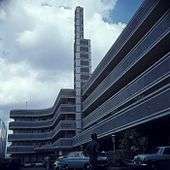
Bandung is home to numerous examples of Dutch colonial architecture; most notably the tropical Art Deco, dubbed New Indies Style. Henri Maclaine Pont was among the first Dutch architects to recognise the importance of combining each architectural style with local cultural traditions. He stressed that modern architecture should interact with local history and native elements.[49] In 1920, Pont planned and designed buildings for the first technical university in the Dutch East Indies, Technische Hogeschool te Bandung (the present-day Bandung Institute of Technology), after which he was named as a Professor of Architecture at the university. A striking local Sundanese roof style is clearly seen adorning the top of the campus' ceremonial hall and is embedded in his artwork.[49]
In the same year, another Dutch architect J Gerber designed Gouverments Bedrijven (Government Companies) in line with the colonial government plan to move the capital from Batavia to Bandung. The building is an example of a harmonious mixture between West and East architectural styles, particularly the Italian Renaissance style of arch structures in the wings and pendopo-like structures commonly found in Java in the middle section. The building is known as Gedung Sate, named after the distinguished small satay-shaped structure on the roof, and is today used as the head office of the West Java provincial government and House of Representatives.
The architectural blending of modern and native traditional was followed by several Dutch architects who shaped the city landmarks. In the 1930s, Bandung became known as an architectural laboratory due to the many Dutch architects who experimented with new architectural designs. Albert Aalbers added the streamline moderne style to the Art Deco by designing the DENIS bank (1936) and renovated the Savoy Homann Hotel (1939). Charles Prosper Wolff Schoemaker was one of the architects who strongly added native elements in his artworks, including the Villa Isola (1932), Hotel Preanger (1929), the regional military headquarter (1918), Gedung Merdeka (1921) and ITB Rectorate Building (1925).[49]
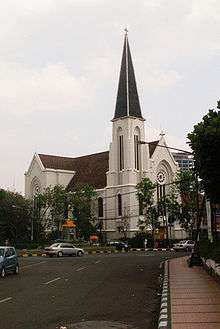
Though Bandung is known for its large number of old Dutch architecture buildings, the city is going through a high-rise building boom recently. At present, there are more than 100 high rise building in the city and many more under construction or planned.[50] The following list includes buildings in Bandung, which are completed or topped off and which are above 300 ft 91 metres.
| Name | Floors | Height m | Year | Image | Note |
|---|---|---|---|---|---|
| Soetta Sky Park | 40 | 162 | 2021 | The tallest building project, topping off 2020[51] | |
| Galeri Cimbuleuit 2 | 36 | 141 | 2014 | At present the tallest building in Bandung[52] | |
| Parahyangan Residences A | 35 | 130 | 2016 | [53] | |
| Newton The Hybrid Park Apartment A | 32 | 121 | 2016 | [54] | |
| Tamansari Panoramic Apartment | 30 | 115 | 2014 | [55] | |
| Ibis Hotel Bandung | 24 | 111 | 2011 | ||
| Newton The Hybrid Park Apartment B | 30 | 110 | 2016 | ||
| Harris Hotel Ciumbuleuit | 28 | 110 | 2014 | ||
| Crowne Plaza Hotel | 21 | 109 | 2014 | ||
| Apartemen Galeri Ciumbuleuit III | 30 | 106 | 2016 | ||
| The Trans Luxury Hotel | 20 | 101 | 2012 | ||
| Newton Hybrid Park III | 26 | 98 | 2017 | ||
| The Jarrdin @Cihampelas Apartment I | 25 | 98 | 2013 | [56] | |
| The Jarrdin @Cihampelas Apartment II | 25 | 98 | 2013 | ||
| The Jarrdin @Cihampelas Apartment III | 25 | 98 | 2013 | ||
| The Jarrdin @Cihampelas Apartment IV | 25 | 98 | 2013 | ||
| Grand Asia Afrika Residence A | 24 | 94 | 2016 | [57] | |
| Grand Asia Afrika Residence B | 24 | 94 | 2016 | ||
| Gateway Apartment A | 23 | 91 | 2013 | ||
| Gateway Apartment B | 23 | 91 | 2012 | ||
| Sudirman Suites Apartment | 22 | ||||
| Apartemen Galeri Ciumbuleuit | 22 | 2005 | |||
Tourism

Bandung is a popular weekend destination for residents of Jakarta. The colder climate of the highland plantation area, variety of food, less expensive fashion shops located in factory outlets and distros, golf courses, and the zoo, are some of the attractions of the city.[58] Bandung is also a popular shopping destination due to the cheap textile and fashion products, especially for Malaysian and Singaporean tourists.[59]
In the 1990s, local designers opened denim clothing stores along Jalan Cihampelas, which was transformed into a "jeans street". The city attracts people from other big cities to buy local fashion wares, as they are cheaper than branded items.[60] Beside Jalan Cihampelas, many factory outlets also opened at Jalan Riau, Jalan Setiabudi, and Jalan Djuanda (known as Dago). Textile factories on the outskirts of Bandung have opened factory outlets on site selling what is marketed as sisa export (rejected or over-produced export quality items).[61] Trans Studio Mall, Bandung Indah Plaza, Cihampelas Walk, Paris Van Java Mall and 23 Paskal Shopping Center are among the popular shopping centres in Bandung.
Significant tourist sites near Bandung include the Tangkuban Prahu volcano crater to the north, the Kawah Putih volcano lake, and Patenggang Lake, a lake surrounded by tea plantations about 50 kilometres (31 miles) to the south of the city.
To view the Bandung Basin clearly in its mountain surroundings, visitors travel to the Bongkor protected forest area (kawasan hutan lindung), Saung Daweung and Arcamanik; to the slopes of West Manglayang Mountain in an area known as Caringin Tilu, with entry from Padasuka and Cicaheum to the north. The forest is located in 1,500 metres (4,900 feet) above sea level and is covered with pine trees managed by a government corporation Perhutani and can be accessed with 30 minutes drive from downtown.[62][63] Visitors going to the north of the city also find Taman Hutan Raya Ir. H. Djuanda. The Cicaheum area also hosts Bukit Moko, a tourist spot famous for its views and its steel statue of a giant star called Puncak Bintang. Bandung has several museums that should be visited by tourists, such as the Geological Museum of Bandung, the Indonesia Postal Museum, Sri Baduga Museum, and the Asian-African Conference Museum. The city government operates Bandros, a tourist bus, since 2014.[64]
Sports
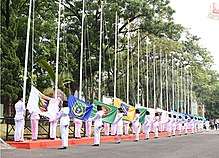
Bandung is the home of Persib Bandung, a professional football club currently competing in the highest tier of Indonesian football, the Liga 1. The JNE Bandung Utama competes in the Indonesian Basketball League, with its home games in the GOR Citra Arena. The roads leading up to Lembang and Dago are popular routes for mountain cycling on weekends, as Jalan Ir. H. Djuanda is zoned as car-free on Sunday mornings.[65]
Other popular sports in Bandung include badminton and golf, with several golf courses surrounding the city.
Media
Bandung has several local daily newspapers, including Pikiran Rakyat, Galamedia, and Tribun Jabar. Several national and local television stations operate in Bandung, including Trans 7, Trans TV, NET., tvOne, RCTI, SCTV, Indosiar, ANTV, MNCTV, GTV, Metro TV, RTV Bandung, Kompas TV Jawa Barat, and TVRI. Many radio stations, such as INTV Bandung, also broadcast from Bandung.
The city of Bandung was featured in the 9th and 10th leg of the American reality series The Amazing Race 23.
Transport
Road
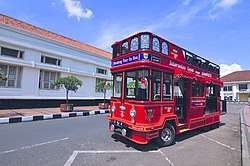
Bandung can be accessed by highways from Jakarta. An intercity toll highway called Cipularang Toll Road, connecting Jakarta, Karawang, Purwakarta, Padalarang and Bandung, was completed in May 2005 and is the fastest way to reach Bandung from the capital by road. Driving time is about 1.5 hours on average. There are three other options: the Puncak route (Jakarta-Cianjur/Sukabumi-Bandung), Purwakarta route (Jakarta-Cikampek-Purwakarta-Cikalong Wetan-Padalarang-Cimahi-Bandung) and the Subang route (Jakarta-Cikampek-Subang-Lembang-Bandung). From cities further east (Cirebon, Tasikmalaya and Central Java province), Bandung can be accessed through the main provincial road. Indonesian National Route 3 links Bandung with the rest of Java towards Cilegon and Ketapang (Banyuwangi).
The Pasupati Bridge was built to relieve traffic congestion in the city for east–west transport. The 2.8-kilometre (1.7 mi) cable-stayed bridge lies through the Cikapundung Valley. It is 30 to 60 metres (98 to 197 feet) wide and, after extensive delays, it was finally completed in June 2005, following financial investment from Kuwait.[66] The bridge is part of Bandung's comprehensive inner-city highways plan.
Taxis and mobile apps transport are widely available. The primary means of public transportation is by angkot minibuses (from angkutan, "transportation" and kota, "city"); angkot are privately operated and serve multiple routes throughout the city, and although cheap, they are considered basic and uncomfortable.[67] To find exact angkot routes, passengers may look for information available through the drivers or at terminals. DAMRI buses operate on longer high capacity routes.
Bandung has two intercity bus terminals: Leuwipanjang, serving buses from the west, and Cicaheum, serving buses from the east. Both are at full capacity and are to be replaced by a new terminal at Gedebage on 15 hectares (37 acres) land, after which the old terminals will function as inner-city terminals. The new terminal will be located next to the Gedebage railway station near Gedebage container dry port.[68]
Air
Bandung Husein Sastranegara International Airport serves direct domestic flights to Batam, Pekanbaru, Medan, Bandar Lampung, Surabaya, Yogyakarta, Semarang, Banjarmasin, Makassar, and also international services to/from Kuala Lumpur and Singapore. The airport is located near the Dirgantara aerospace complex and Dirgantara Fairground. The Kertajati International Airport in Majalengka Regency is built to replace the Husein Sastranegara Airport.[69][70]
Railway
Bandung has two large railway stations, Bandung and Kiaracondong Stations. Other smaller stations are Cimindi, Andir, Ciroyom, Cikudapateuh, and Gedebage Stations (only for freight service). Railway lines connect Bandung to Cianjur, Jakarta, Purwakarta, Bekasi, Karawang, and Cikampek to the west, and Surabaya, Malang, Yogyakarta, and Solo to the east. It is also a major means of transportation for people living in the suburban areas of Cimahi, Padalarang, Rancaekek, Cicalengka, and Cileunyi. In 2012, Bandung Commuter Train phase-1 was scheduled to be built to connect Padalarang, Cimahi, Bandung, and Cicalengka with 13 Trans Metro Bandung bus corridors to serve as feeders. Phase-2 will connect Cicalengka to Jatinangor.[71]
Current and future development
Thirty-two bus shelters for Trans Metro Bandung (similar to TransJakarta) along Jalan Soekarno-Hatta were finished in August 2011 at the cost of Rp 13.1 billion ($1.54 million). Thirty additional buses joined the existing operation of ten buses after all the shelters were finished.[72]
On 21 June 2011, Perum DAMRI launched two buses on the Cibiru-Kebon Kelapa especially for female passengers only with female drivers.[73]
On 5 August 2011, Jusuf Kalla announced that he would like to build a monorail in Bandung with a value of Rp 4 trillion ($470 million).[74]
As of April 2012, a cable car project 'Bandung Skybridge' to connect Pasteur (Cihampelas) to Sabuga (Taman Sari) was said to be 90% complete and awaiting legal authorisation to operate.[75] However, as of 2016, the project has still to be realised. To ease Cihampelas traffic congestion, the city mayor, Ridwan Kamil inaugurated a skywalk for pedestrians only from Cihampelas to Tamansari on 4 February 2017. The skywalk, named Teras Cihampelas, was built with a budget of Rp 45 billion.[76] Vehicles will be able to be parked at Tamansari.[77] The city has also announced an intention to build LRT (Light Rail Transit).
Education
Bandung has nearly 50 higher educational institutions and is among the most popular destinations for education in Indonesia. There are hundreds of public and private schools in the city and several state-funded and administered Junior High Schools (SMP Negeri) and State High Schools (SMA Negeri). At least sixteen universities—three of which are state-owned—and 45 professional schools are scattered across the city. Education from social sciences and technology to tourism education can be found at one of these universities.
Among the universities located in Bandung include Bandung Institute of Technology (Institut Teknologi Bandung, ITB), Universitas Padjadjaran (Padjadjaran University), National Institute of Technology (Indonesia) (Institut Teknologi Nasional), Parahyangan Catholic University, Universitas Islam Bandung, (Bandung Islamic University), Universitas Kristen Maranatha (Maranatha Christian University), Universitas Islam Nusantara (Nusantara Islamic University), Universitas Pendidikan Indonesia (Indonesia University of Education), Universitas Islam Negeri Sunan Gunung Djati (Sunan Gunung Djati Islamic State University), Universitas Pasundan (Pasundan University), Institut Teknologi Telkom (Telkom Institute of Technology), Politeknik Negeri Bandung (Bandung State Polytechnic), and Sekolah Tinggi Pariwisata Bandung (Bandung Institute of Tourism), all being considered among the best universities in their respective fields of speciality in Indonesia. Established in 1920, ITB is Indonesia's oldest and most prestigious technical university. Universitas Pendidikan Indonesia (formerly IKIP Bandung, established in 1954) Universitas Komputer Indonesia (UNIKOM) is one of the first institutions of higher education established after Indonesian independence and is currently a leading education university in the country. Universitas Padjadjaran (established in 1956) is considered to be one of the best universities in the country in the fields of medicine, law, communication, and economics.
International schools are also available in the city. They include the Bandung Alliance Intercultural School, Bandung Independent School, Bandung Japanese School, Bina Bangsa School Bandung, Bina Persada School, and Stamford School. In the north of Bandung, Bosscha Observatory is the only observatory in Indonesia. Construction of the observatory began in 1923 and was completed in 1928. In 1922, the first international publication from Bosscha Observatory was published, and in 1959, the observatory was absorbed as a part of the Department of Astronomy at the Bandung Institute of Technology).
Notable people
Sister cities
Bandung has sister relationships with a number of towns worldwide:














.svg.png)
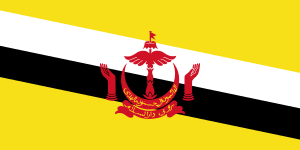
References
- http://disdik.jabarprov.go.id/news/461/asal-muasal-dan-sejarah-bandung
- Data Sensus Penduduk 2010 - Badan Pusat Statistik Republik Indonesia <http://sp2010.bps.go.id/index.php/site/tabel?tid=321&wid=3200000000&lang=id>
- https://jabar.bps.go.id/dynamictable/2020/05/20/485/pdrb-atas-dasar-harga-berlaku-menurut-kabupaten-kota-2019.html
- Badan Pusat Statistik, Jakarta, 2020.
- http://www.citypopulation.de/php/indonesia-jawa-admin.php
- "Bandung Wins Cleanest Air Award From Asean". Jakarta Globe. Retrieved 13 September 2017.
- Chandran, Nyshka (13 September 2017). "Architect-turned-mayor transforms his hometown into Indonesia's least bureaucratic city". CNBC. Retrieved 24 January 2018.
- Valentina, Jessicha (2 March 2017). "Bandung is Indonesia's leading smart city: Eco-architect". The Jakarta Post. Retrieved 24 January 2018.
- "Archived copy". Archived from the original on 4 February 2017. Retrieved 3 February 2017.CS1 maint: archived copy as title (link)
- https://bisnis.tempo.co/read/1282014/pt-kai-mulai-garap-pengumpan-kereta-cepat-jakarta-bandung
- B. Brahmantyo; E. Yulianto and Sudjatmiko (2001). "On the geomorphological development of Pawon Cave, west of Bandung, and the evidence finding of prehistoric dwelling cave". JTM. Archived from the original on 8 April 2008. Retrieved 21 August 2008.
- "Pramoedya sheds light on dark side of Daendels highway". The Jakarta Post. 8 January 2006.
- Peter .J.M Nas; Pratiwo (2001). "Java and De Groote Postweg, La Grande Route, The High Military Road" (PDF). University of Leiden. Retrieved 22 June 2009. Cite journal requires
|journal=(help) - Kunto, Haryanto (1984). Wajah Bandung Tempoe Doeloe. Granesia.
- Soemardi, Ahmad R.; Radjawali, I (2004). "Creative culture and urban planning: The Bandung Experience" (PDF). The eleventh International Planning History Conference 2004. Retrieved 21 August 2006.
- "If Only Junghuhn Knows How Cinchona in Indonesia Becomes..." (in Indonesian). Pikiran Rakyat. 7 June 2004. Archived from the original on 17 May 2006. Retrieved 21 August 2006.
- "An Extremely Brief Urban History of Bandung". Institute of Indonesian Architectural Historian. Archived from the original on 16 July 2006. Retrieved 20 August 2006.
- Sitaresmi, Ratnayu. "Social History of Bandung Lautan Api (Bandung Sea of Fire) 24 March 1946" (PDF). Archived from the original (PDF) on 3 June 2017. Retrieved 22 August 2008. Cite journal requires
|journal=(help) - Jamie Mackie, 'Bandung 1955: Non-Alignment and Afro-Asian Solidarity', Singapore, Editions Didier Millet, ISBN 981-4155-49-7
- Jason Parker (2006). "Cold War II: The Eisenhower Administration, the Bandung Conference, and the Reperiodization of the Postwar Era". Diplomatic History. 30 (5): 867–892. doi:10.1111/j.1467-7709.2006.00582.x.
- Richard Wright (1995). The Color Curtain: A Report on the Bandung Conference. University Press of Mississippi. ISBN 0-87805-748-X.
- Discover Bandung Archived 7 March 2013 at the Wayback Machine
- W.A. van der Kaars & M.A.C. Dam (1995). "A 135,000-year record of vegetational and climatic change from the Bandung area, West-Java, Indonesia". Palaeogeography, Palaeoclimatology, Palaeoecology. 117 (1–2): 55–72. doi:10.1016/0031-0182(94)00121-N.
- Setiawan Wangsaatmaja, Arief D. Sutadian and Maria A.N. Prasetiati. "Groundwater Resource Management in Bandung". Sustainable Groundwater Management in Asian Cities. Institute for Global Environmental Strategies. Archived from the original on 2 September 2006. Retrieved 21 August 2006.
- M.N. Kartadinata; M. Okuno; T. Nakamura; T. Kobayashi (2002). "Eruptive History of Tangkuban Perahu Volcano, West Java, Indonesia: A Preliminary Report" (PDF). Journal of Geography. 111 (3): 404–409. doi:10.5026/jgeography.111.3_404. Archived from the original (PDF) on 23 August 2006. Retrieved 21 August 2006.
- Dam, M.A.C. (1994). "The Late Quaternary Evolution of the Bandung Basin, West Java, Indonesia". Ph.D. Thesis. Universiteit van Amsterdam. Cite journal requires
|journal=(help) - van Bemmelen, R.W. (1949). The Geology of Indonesia, Vol. 1A, General Geology.
- "Sangiangtikoro is not The Leaking Point of The Old Bandung Lake" (in Indonesian). Pikiran Rakyat. 27 October 2005. Archived from the original on 29 September 2007. Retrieved 20 July 2006.
- "INDONESIA - HUSEIN SASTRANEG". Centro de Investigaciones Fitosociológicas. Retrieved 26 June 2016. |
- "Bandung, Indonesia - Monthly weather forecast and Climate data". Weather Atlas. Retrieved 25 July 2020.
- Fahmudin, Agus; Wahyunto. "Evaluation of Flood Mitigation Function of Several Land Use Systems in Selected Areas of West Java, Indonesia" (PDF). Japan / OECD Expert Meeting on Land Conservation Indicators. OECD.
- SP 18 May 2006 http://www.sp18.com/2006/05/
- "Trash in Bandung Fears Uncollected" (in Indonesian). Pikiran Rakyat. 23 February 2005.
- "From Bandung Ocean of Flame to the Ocean of Trash". Kompas (in Indonesian). 25 March 2005. Archived from the original on 25 June 2013.
- "Pemkot Bandung Berupaya Raih Kembali Adipura". Pikiran Rakyat Online. Retrieved 8 January 2016.
- "Kota Bandung Raih Penghargaan Adipura :: Bandung.go.id | Portal Resmi Kota Bandung". portal.bandung.go.id. Retrieved 8 January 2016.
- "Bandung Wins Cleanest Air Award From Asean". Retrieved 19 September 2017.
- "Bandung Dalam Angka (Bandung in Numbers)" (Press release) (in Indonesian). Bureau of Statistics. 2003. Retrieved 15 January 2007.
- Dinas Penataan Ruang Kota Bandung (10 February 2017). "Data Spasial Sub Wilayah Kota Bandung". Portal Data Bandung.
- "Keanggotaan DPRD Kota Bandung Periode 2014-2019 – DPRD KOTA BANDUNG" (in Indonesian). Bandung City Council. Retrieved 26 March 2019.
- ": DATA KECAMATAN DI LINGKUNGAN PEMERINTAH KOTA BANDUNG: Berdasarkan PERDA 2008" (PDF). Archived from the original (PDF) on 13 October 2017. Retrieved 1 February 2019.
- Biro Pusat Statistik, Jakarta, 2011.
- "From Indie to Magic". Kompas (in Indonesian). 22 August 2003. Archived from the original on 29 September 2007. Retrieved 21 August 2006.
- "Tujuh Sentra Industri Jadi Ciri Bandung 2013". 6 March 2012.
- Rivers, Paul (13 December 2015). "Unesco names Singapore and Bandung as Creative Cities of Design - Asean Economist". Asean Economist. Retrieved 3 October 2018.
- Profil Daerah Jawa Barat Archived 30 December 2013 at the Wayback Machine
- http://www.tempointeraktif.com/hg/bandung/2010/09/01/brk,20100901-275625,id.html Archived 31 May 2014 at the Wayback Machine TempoInteraktif: Bandung Kota Terpadat di Jawa Barat
- "Jumlah Pendududuk Menurut Jenis Kelamin Dan Kecamatan Di Kota Bandung 2011-2014". Badan Pusat Statistik Kota Bandung. Badan Pusat Statistik Kota Bandung. Retrieved 5 December 2015.
- W. Wangsadinata & T.K. Djajasudarma (1995). "Architectural Design Consideration for Modern Buildings in Indonesia" (PDF). INDOBEX Conf. on Building Construction Technology for the Future: Construction Technology for Highrises & Intelligence Buildings. Jakarta. Archived from the original (PDF) on 14 June 2007. Retrieved 18 January 2007.
- "High-rise buildings in Bandung".
- "Galeri Cimbuleuit 2". Missing or empty
|url=(help) - "Galeri Cimbuleuit 2".
- "Parahyangan Residences A".
- "Newton The Hybrid Park Apartment A".
- "Tamansari Panoramic Apartment".
- "The Jarrdin Apartment".
- "Grand Asia Afrika Residence A".
- Java Experience http://travel.ciao.co.uk/Java_Experience_5297272_5 Archived 8 May 2006 at the Wayback Machine
- Malaysians flock to Bandung to shop
- Asia Travel http://www.asiatravel.com/bandinfo.html Archived 28 August 2006 at the Wayback Machine
- The Lively Pulse of Bandung "Archived copy". Archived from the original on 27 April 2006. Retrieved 28 August 2006.CS1 maint: archived copy as title (link)
- "Pinus yang Mengiurkan". 21 August 2014.
- "The Wind Breeze of Bongkor Forest". 1 September 2014.
- "Kota Bandung Resmi Operasikan Bus Wisata "Bandros"". Antara. Retrieved 7 May 2014.
- http://www.bandungview.info/2013/10/car-free-day-dago.html
- "Kuwait Investasikan 1,5 Milyar Dollar AS di Indonesia" [Kuwait invested USD 1.5 billion in Indonesia]. Kompas (in Indonesian). 14 October 2002. Archived from the original on 11 March 2007. Retrieved 23 August 2006.
- Bandung Transport and Car Rental: Bandung, West Java, Indonesia
- "Bappeda Targetkan Studi Kelaikan Terminal Gedebage Selesai Tahun Ini". Pikiran Rakyat. 2 June 2011. Archived from the original on 24 March 2012.
- "Angkasa Pura II Named Kertajati Airport Operator". Tempo. Retrieved 24 July 2017.
- "Angkasa Pura II to Operate Kertajati, West Java's Biggest Airport". Jakarta Globe. Archived from the original on 25 July 2017. Retrieved 24 July 2017.
- "Transportasi Kota – KRL Komuter Bandung Dibangun". Koran Jakarta. 29 November 2011. Archived from the original on 26 April 2012.
- "Shelter Trans Metro Bandung Ditargetkan Rampung Akhir Agustus 2011". Pikiran Rakyat. 21 July 2011. Archived from the original on 24 March 2012.
- Bandung introduces women-only buses | The Jakarta Post
- Jusuf Kalla Siapkan Rp 4 Triliun untuk Monorel Bandung - Tribunnews.com
- ""Bandung Skybridge" akan Direalisasikan". Pikiran Rakyat. 20 April 2012. Archived from the original on 22 April 2012.
- Saokani, Kukuh (5 February 2017). "Skywalk Cihampelas Bandung Hadir untuk Manjakan Pejalan Kaki". liputan6.com (in Indonesian). Retrieved 18 March 2017.
- "Bandung Skywalk Tahap Pertama Dibangun di Cihampelas". 8 February 2014.
- "Fort Worth". Sister Cities International. Archived from the original on 13 April 2014. Retrieved 11 April 2014.
- "Braunschweigs Partner und Freundschaftsstädte" [Braunschweig – Partner and Friendship Cities]. Stadt Braunschweig [City of Braunschweig] (in German). Archived from the original on 1 December 2012. Retrieved 7 August 2013.
- M Zezen Zainal M (21 September 2019). "Sarawak Malaysia Jajaki Kerjasama Sister City dengan Kota Bandung" [Sarawak Malaysia Establish Sister City Co-operation with Bandung City] (in Indonesian). Bandung Kita. Archived from the original on 26 September 2019. Retrieved 26 September 2019.
- Brilliant Awal (21 September 2019). "Sarawak Malaysia Ajak Kota Bandung Jadi Sister City" [Sarawak Malaysia Invites Bandung City To Become Sister City] (in Indonesian). Gala Media News. Archived from the original on 26 September 2019. Retrieved 26 September 2019.
- "A second sister city for PJ". starproperty.my. Archived from the original on 11 August 2012. Retrieved 11 August 2012.
- "Namur, Bandung ink sister-city partnership"
External links
| Wikimedia Commons has media related to Bandung. |

- The official website of Bandung Government
- Your Bandung
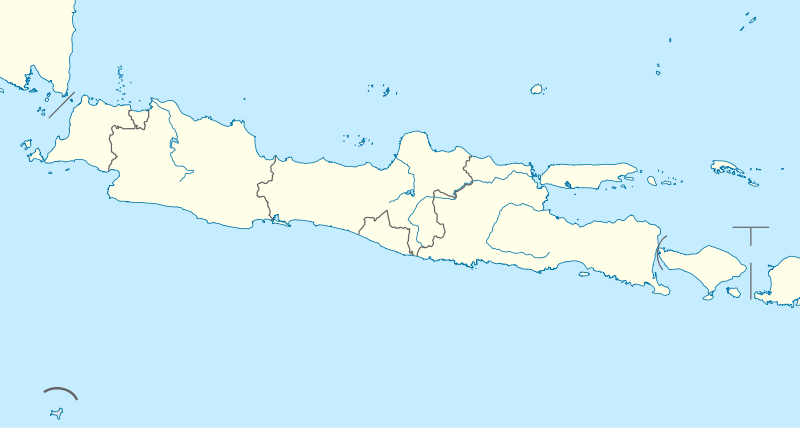
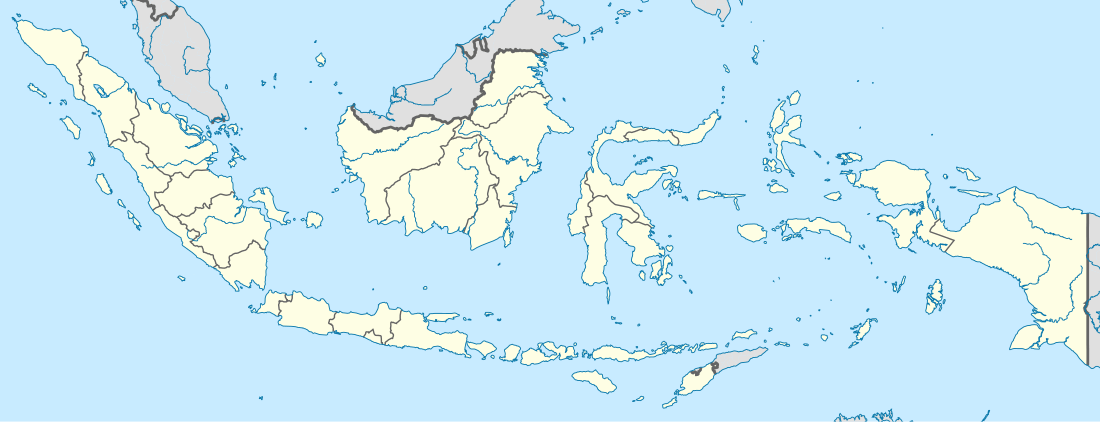

.jpg)
